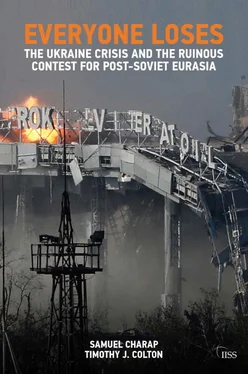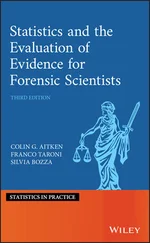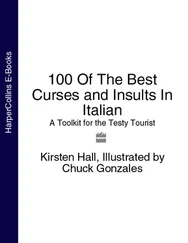A close study of both security-and economic-policy fields by the Carnegie Endowment for International Peace found in 1999 that ‘all of the post-Soviet states, including Russia, are too weak, distracted, and poor to be able to integrate’. ‘Even the few common undertakings to which the CIS states have been able to agree have either been carried out shoddily or not at all, because neither Russia nor the other CIS states have the money to pay for them.’ [66] Martha Brill Olcott, Anders Aslund and Sherman W. Garnett, Getting It Wrong: Regional Cooperation and the Commonwealth of Independent States (Washington DC: Carnegie Endowment for International Peace, 1999), pp. 95–6.
Nor did Russia have the organisational arena to itself. In October 1997 four In-Between abstainers or dropouts from the CSTO and the Economic Union Treaty formed a rival group known as GUAM, after the founding parties of Georgia, Ukraine, Azerbaijan and Moldova. GUAM was a talk shop about how to keep the Russians at bay and open up channels to the West (doing the talking in Russian, its official language). It gained observer status at the UN General Assembly in 2003, but would wait until 2006 to organise a secretariat (with all of eight staffers) in Kyiv. The member governments announced a free-trade area in July 2002 and signed a sprinkling of joint statements, installed a parliamentary assembly and working groups, and discussed at length a Europe–Caucasus–Asia Transport Corridor and a GUAM peacekeeping brigade. Little of substance came of these initiatives, which can be attributed to the same constellation of factors that plagued the Russia-led projects. [67] The eight working groups, for example, largely limited themselves to one annual meeting each, often on the margins of larger gatherings. A number of agreements were never implemented, and others went into effect in only one or several of the member states. Details on the GUAM organisation can be found at http://guam-organization.org/ and more lucidly at a site maintained by one of the GUAM principals, Moldova: http://www.mfa.gov.md/about-guam-en/ .
GUAM tried but was ultimately unable to widen its membership: Uzbekistan, which signed on in 2001 (making it GUUAM), ceased to participate in 2002 and abandoned it in 2005.
In the first decade or so after the Soviet collapse, the role of Western governments in these meanderings was modest. The 1999 Carnegie Endowment study concluded that no CIS member state was a serious candidate for NATO admission, and that PfP was mostly of ‘no more than a marginal influence’, attuned to bland endeavours like search-and-rescue training rather than hard geopolitics. [68] Olcott, Aslund and Garnett, Getting It Wrong , p. 208.
The EU approach to post-Soviet Eurasia until 2004 was ‘Russia first’, other than allowing the three Baltics to apply for accession. As with NATO’s efforts, the In-Betweens were involved only tangentially. Between 1995 and 1999, all six went for PCAs that provided for political dialogue and economic advice. Words almost universally outpaced deeds. Moldova may serve as an illustration: it ‘repeatedly heralded European integration but did little to honor its obligations, and Europe remained only marginally interested in the small country’. [69] Jakob Tolstrup, Russia vs. the EU: The Competition for Influence in Post-Soviet States (Boulder, CO: Lynne Rienner, 2013), p. 130.
American diplomats who served at the time recount that Washington’s prime aim was to craft a ‘presence’ in every capital – an embassy, a military attaché, trade and aid missions, and so on – and to forge working relationships with the fledgling countries. Russian diplomats will say the Americans and less so the Europeans bad-mouthed all Russian integrationist moves as neo-Soviet. As one of them put it in an interview, ‘They were constantly throwing a spanner in the works…. Any action we took was considered an attempt to bring back the Soviet Union.’ [70] Authors’ interview with a former senior Russian official, December 2015.
There is some truth to the Russian allegation. Inspired by Zbigniew Brzezinski, a former US national security adviser who warned in 1994 of Russia’s ‘proto-imperial’ leanings, some policymakers did see Russia as bent on re-establishing an anti-Western bloc with the In-Betweens and the Central Asians. [71] For Brzezinski’s initial statement to this effect, see Zbigniew Brzezinski, ‘The Premature Partnership’, Foreign Affairs , vol. 73, no. 2, March–April 1994, pp. 67–82.
The ritualistic endorsements of these states’ sovereignty and territorial integrity intimated that Russia represented a threat to both. As then-US secretary of state Christopher brusquely put it, ‘Russia must avoid any attempt to reconstitute the U.S.S.R.’ [72] Warren Christopher, ‘NATO PLUS’, Washington Post , 9 January 1994, https://www.washingtonpost.com/archive/opinions/1994/01/09/nato-plus/88b3d1a6-8111-4491-bbf0-e6267b0dae95/?utm_term=.0fe94b86f2ed .
But the push to show the flag and the finger-pointing at an alleged Soviet-style approach to the region did not beget a Western eagerness to get tangled in local conflicts or to act systematically to thwart Russian policy. As one former practitioner recalls, ‘Despite loud warnings from political and academic critics that Moscow was seeking to restore… control, many Western European states, and even the United States, accepted and at times welcomed Russian actions to stop the fighting and try to manage the conflicts on its periphery.’ [73] William H. Hill, Russia, the Near Abroad, and the West: Lessons from the Moldova – Transdniestria Conflict (Washington DC: Woodrow Wilson Center Press, 2012), p. 36.
In the early and mid-1990s, crises in the Persian Gulf and strife-torn Somalia and the Balkans seemed more salient, and absorption of the one-time Warsaw Pact states and the three Baltic countries was mission enough for even the most evangelical NATO supporters. [74] Ronald Asmus of the RAND Corporation, who would shortly join the Clinton administration, wrote with two fellow enlargement advocates in 1995 that for the time being, ‘The West would prefer to have a Finlandised Ukraine – politically and economically stable and pro-Western, but militarily neutral’. Ronald D. Asmus, Richard L. Kugler and F. Stephen Larrabee, ‘NATO Expansion: The Next Steps’, Survival: Global Politics and Strategy , vol. 37, no. 1, Spring 1995, pp. 7–33.
Primakov took pride in Russia’s having made a place for OSCE and UN observers in its peacekeeping missions in Georgia, and remarked wryly that ‘no one was in any hurry to replace the Russians, let alone to repeat what NATO had done in Bosnia’. [75] Primakov, Vstrechi na perekrestkakh , p. 371.
Russia’s economic woes spurred its neighbours to diversify their trade ties. The total exports of the 11 non-Russian CIS countries to the EU overtook the volume of their exports to Russia by 1998. The most prominent Western geo-economic incursion was occasioned by the bounteous petroleum reserves of the Caspian Sea basin. Oil- and gas-rich Azerbaijan, on the western coast, and Kazakhstan on the eastern, began to clamour for the liberty to deal with multinational oil companies without hindrance from Moscow even before December 1991. Multi-cornered wrangling in subsequent years produced a cavalcade of deals and joint ventures, many of them dead letters. The pinch point was transportation: getting the fuel to outside markets. Russia strived to monopolise this function through its pipeline network. Shevardnadze, now the Georgian president, and his counterpart Heydar Aliev of Azerbaijan lobbied for a route originating in Azerbaijan and stretching through Georgia to Ceyhan, a Turkish marine terminal on the Mediterranean. It was their brainchild that was eventually built, much to Russia’s chagrin. A bureaucratic faction in Washington brought the US into the loop, on the grounds that ‘it was incumbent upon the American government to come to the aid of the Caspian republics – in effect, to run interference for them against Russia’. [76] Steve LeVine, The Oil and the Glory: The Pursuit of Empire and Fortune on the Caspian Sea (New York: Random House, 2007), p. 215.
The geopolitical and geo-economic logic was that by breaking Russia’s export monopoly, the new pipeline would provide both producer and transit countries with independent revenue streams, thus limiting Russian influence over their affairs. But the Clinton administration was also accommodating toward a second pipeline through Russia, and Moscow was restrained in its reaction to the setback. Russia had other fish to fry, the Caspian was a low priority for Yeltsin, and he was averse to the use of force to have his way, despite Shevardnadze’s taking fright that the Russian military would ‘blow me up’ if he persisted. [77] Ibid. , p. 221. Russian calculations are well laid out in Douglas W. Blum, ‘The Russian–Georgian Crisis and Baku–Tbilisi–Ceyhan’, PONARS Policy Memo, no. 252, October 2002, http://www.ponarseurasia.org/sites/default/files/policy-memos-pdf/pm_0252.pdf .
Russia stayed out of the consortium but was free to lay down more pipe itself, which it did in later years. Agreement in principle on the 1,768km Baku–Tbilisi–Ceyhan Pipeline was reached in November 1998, ground was broken in 2003 and the first crude was pumped in 2005.
Читать дальше











